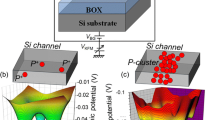Abstract
Molecular electronics on silicon substrates hold promise for new functional possibilities on silicon. One such possibility is a hybrid silicon-molecule device that shows negative differential resistance (NDR) when conduction through the molecular levels are cut-off as the levels are driven into the silicon band-gap region. We demonstrate through a self-consistent solution based on Non-equilibrium Green’s Function (NEGF) formalism that the NDR peaks show a clear polarity dependence, appearing for only positive bias on a p-doped substrate. We further discuss what determines the position of the NDR peaks and how the locations are affected by self-consistency.
Similar content being viewed by others
References
G.P. Lopinski et al., “Self-directed growth of Molecular Nano-Structures on Silicon,” Science, 406, 48 (2000).
P.S. Damle et al., “Unified description of molecular conduction: From molecules to metallic wires,” Physical Review B, 64(20), 201403 (1995).
N. Guisinger et al., “Room temperature negative differential resistance through individual organic molecules on silicon surfaces,” Nano Lett., 55(22), 1234 (1995).
T. Rakshit et al., “Silicon-based molecular electronics,” Nano Lett., 4(10), 1803 (2004).
S. Datta, Electronic Transport in Mesoscopic Systems (Cambridge University Press: Cambridge, 1995).
S. Datta, “Electrical resistance: An atomistic view,” Nanotechnology, 15, S-433 (2004).
M.J. Frisch et al., “GAUSSIAN98,” revision A.7; Gaussian, Inc.: Pittsburgh, PA, 1998.
Technology Modeling Associates, Inc.: Sunnyvale, CA, “TMA medici, two-dimensional device simulation program, version 4.0 user’s manual” (1997).
H. Lund et al., Organic Electrochemistry (M. Dekker Inc., 1990).
M. McEllistrem et al., “Electrostatic sample-tip interactions in scanning tunneling microscopy,” Phys Rev. Lett., 70(16), 2471 (1993).
J.M. Blanco et al., “First-principles simulation of STM images: From tunneling to the contact regime,” Phys Rev. B, 70(4), 085405 (2004).
A.W. Ghosh et al., in preparation.




